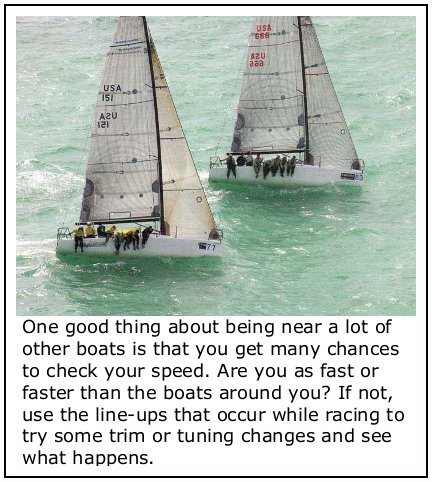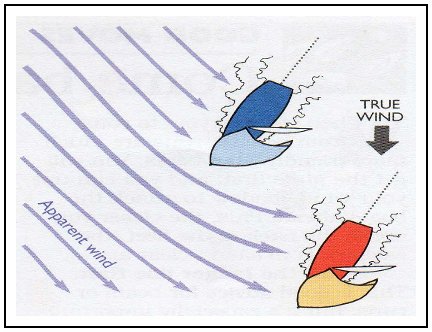|
Keep your speed up
by David Dellenbaugh
When you’ve fallen behind, good
boatspeed is absolutely key for
making a comeback. But it’s not easy to
go fast in the middle of the fleet. It can
be tough just keeping up with the leaders,
not to mention catching them.
Therefore, you must work extra hard at
steering, sail trim and boathandling.

When you’re in the middle of the
pack, you often have to sail in bad air
and bumpy water, and you must usually
tack more frequently than the boats
ahead. Therefore, set up your sails so
they are good for acceleration and
power. Some ways to do this include:
• Make your sails a little fuller and more powerful;
• Move their draft forward slightly(by using less backstay and mainsheet)
to improve acceleration;
• Ease your sheets slightly to add twist and make a wider groove; and
• Don’t try to point too high.
When you are sailing in bad air,
you will probably have to find a
“groove” where you go more for forward
speed than height. This means
you must also adjust your strategy and
tactics for this type of performance. For
example, make sure you can lead other
boats toward the next shift, and avoid
getting into positions where you have
to hold a thin lane with other boats
close to leeward.
Of course, the best way to go fast
when you're back in the pack is to find
clear air. So look carefully for a good
“lane” and do everything you can to protect
it for yourself. If you do find clean
air and water for a while, be sure to
“change gears” by adjusting your sail
shapes.
Use other boats to help
One reason why it’s important to focus
on boatspeed during a comeback is
because speed might have been the reason
(or one reason) why you fell behind
in the first place. Perhaps you had trouble
holding your lane right after the start
and fell into bad air. Or the other boats
just seemed to be going a little better
through the water.
In that case, you need to get your
boat going faster as soon as possible or
you will fall further and further behind.
Fortunately, one of the good things
about being in the middle of the pack is
that there are almost always other boats
nearby. Use these “obstacles” to measure,
and improve your speed.

Whenever you are in a good lineup
with another boat (as in the photo), use
this chance to a) gauge how well you are
sailing; and b) if you’re not going as fast
or high, try changing some things to see
if you can get going faster.
Good speed require constant communication
between sail trimmers and
the helmsperson, plus a focus on changing
conditions. This can be challenging
when you’re in the middle of making a
comeback because there is a lot happening.
It requires extra effort to eliminate
or tune out all extraneous “noise.”
Dave publishes the newsletter
Speed & Smarts.For a subscription
call: 800-356-2200 or go to:
www.speedandsmarts.com
TOP
|